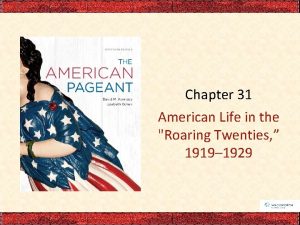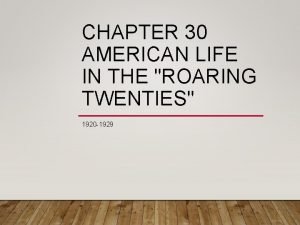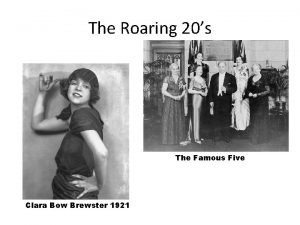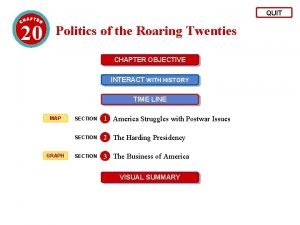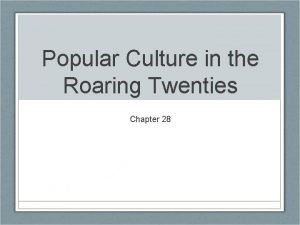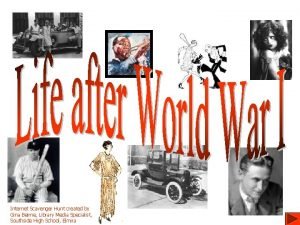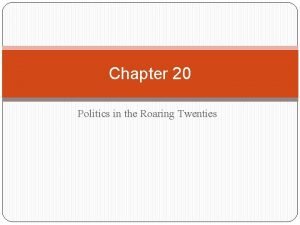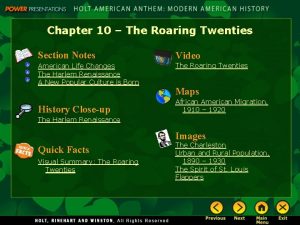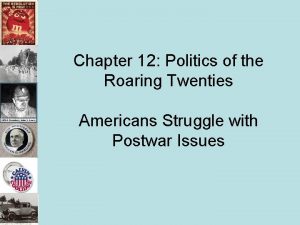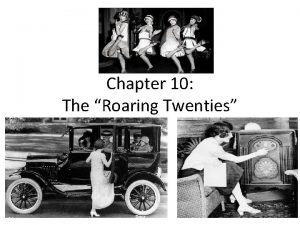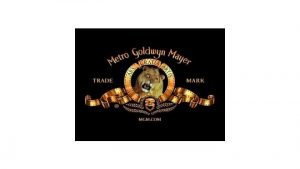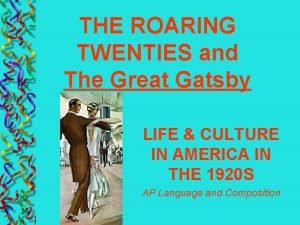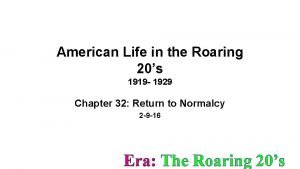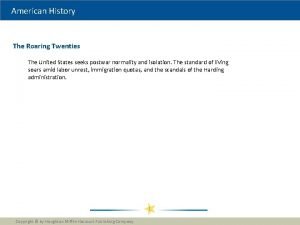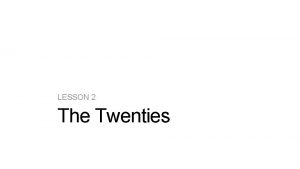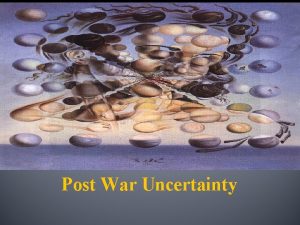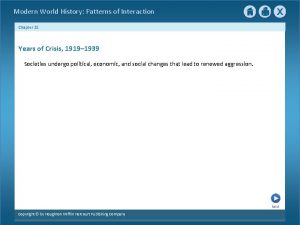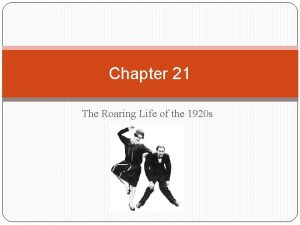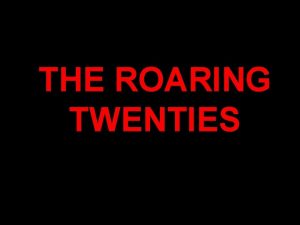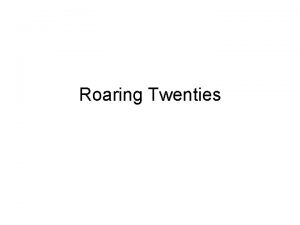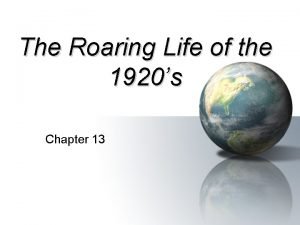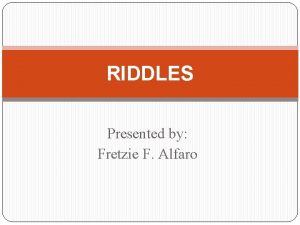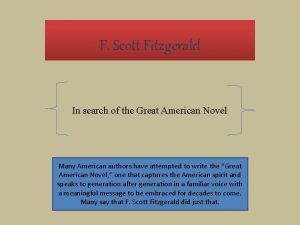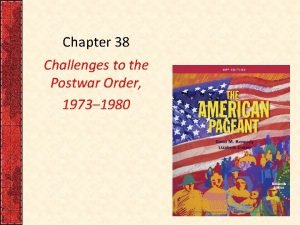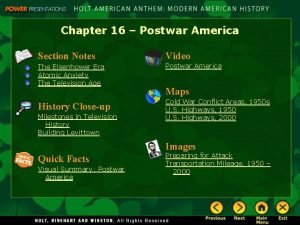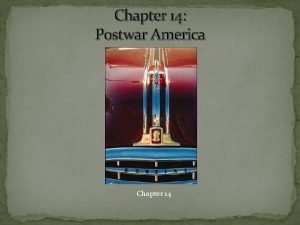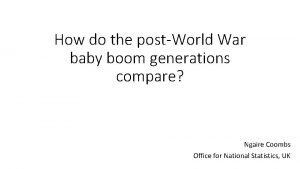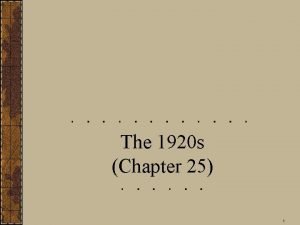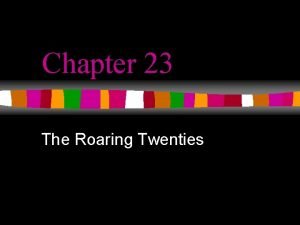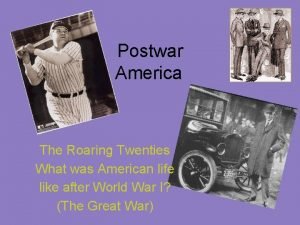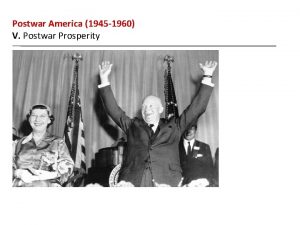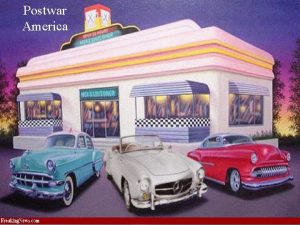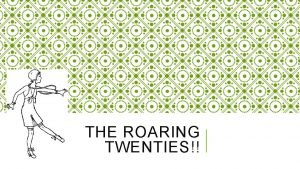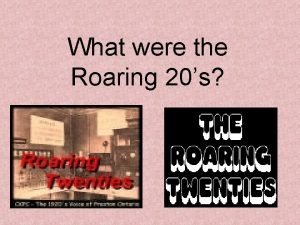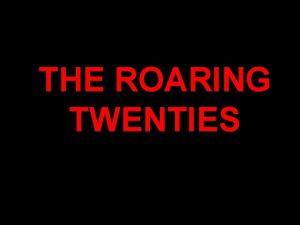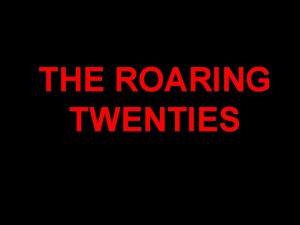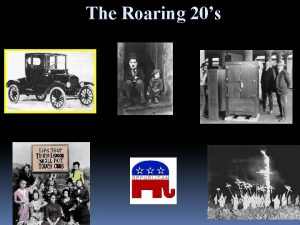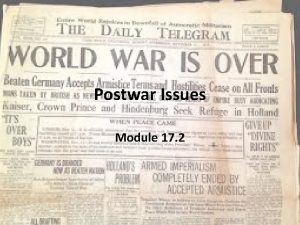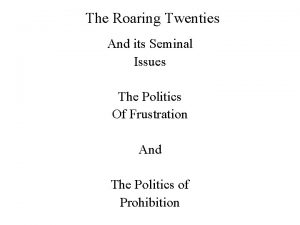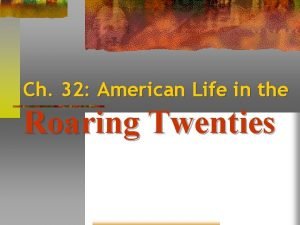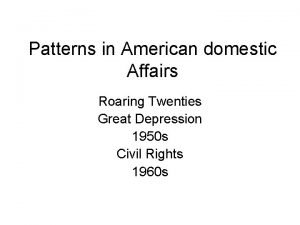THE ROARING TWENTIES SECTION 1 AMERICAN POSTWAR ISSUES






































































- Slides: 70

THE ROARING TWENTIES

SECTION 1: AMERICAN POSTWAR ISSUES • The American public was exhausted from World War I • Demobilization • International issues dealing with peace • What would be the role for Women and Minorities?

Demobilization • One of the main issues the US had to face was demobilization --- the process by which soldiers returned home and began their lives again as civilians. • Millions of former soldiers left service. • What are the effects of demobilization?

The 20’s Response to Change • In response, many welcomed changes that challenged established social roles, partly because they were consistent with the prosperity. • Yet many feared domestic and foreign threats.

AMERICAN BUSINESS FLOURISHES • Presidents in the 20’s favored policies that kept taxes down and business profits up • Tariffs were high which helped American manufacturers • Government interference in business was minimal, Laisse Faire economics.

THE BUSINESS OF AMERICA The new president, Calvin Coolidge, fit the probusiness spirit of the 1920 s very well His famous quote: “The chief business of the American people is business. . . the man who builds a factory builds a temple – the man who works there worships there” President Calvin Coolidge 1924 -1928

Effects of Laisse Faire economics in the 20’s Wages rose. Delusional Attitude. During the 1920 s, most Americans believed prosperity would go on forever Materialism. Widening Income Gap. Stock Market Took Off

Foreign Policy: Loans and Tariffs • New conflicts arose when it came time for Britain and France to payback loans they had borrowed • They could do this by collecting payment from German Reparations or by exporting to the US. • However The Fordney-Mc. Cumber Act in 1922 made it impossible for Europeans to pay war debt. • That year, Germany defaulted on payments.

Foreign Policy: Dawes Plan • French troops mobilized to insure payments. In order to avoid war, the US loaned Germany $2. 5 billion to pay back Britain and France with annual payments on affixed scale --Dawes Plan. • The solution caused resentment all around

Dawes Plan which solved the problem of post-war debt by providing loans to Germany to pay France/Britain who then paid the U. S.

Foreign Policy: Isolationism After being disillusioned after WWI, Americans viewed the nations of Europe as conflict prone and likely draw in the United States into another war which really had little to do with American interests. Isolationism meant pulling away from involvement in world affairs.

Foreign Policy: World Peace • The Washington Naval Conference in 1921, the USA, Japan, Britain and France agreed to limit the size of their navies and agreed to maintain the status quo in the Pacific, by respecting the Pacific holdings in the 4 Powers Treaty. • Kellogg-Briand Pact which renounced war as a means of national policy (signed by 15 nations, but difficult to enforce) • WILPF --- Peace Organization Harding 1920 -1924

SCANDAL HITS HARDING • Several of Harding’s appointee’s were caught illegally selling government supplies to private companies

TEAPOT DOME SCANDAL The worst case of corruption was the Teapot Dome Scandal The government set aside oilrich public land in Teapot, WY Secretary of Interior Albert Fall secretly leased the land to two oil companies Fall received $400, 000 from the oil companies and a felony conviction from the courts

Roaring 20’s and Civil Liberties

Causes of Nativism • A wave of nativism, or prejudice against foreign-born people, swept the nation. • Causes: • organized labor believed cheap immigrant labor forced down wage • radical political movement and ideologies such as communism viewed as European in origin

THE KLAN RISES AGAIN • The KKK was devoted • to“ 100 percent Americanism. • The Klan dominated state politics in many states • By 1924, the Klan had 4. 5 million members

CONGRESS LIMITS IMMIGRATION Congress, in response to nativist pressure, decided to limit immigration from southern and eastern Europe The Emergency Quota Act of 1921 set up a quota system to control and restrict immigration America changed its formally permissive immigration policy

FEAR OF COMMUNISM One perceived threat to American life was the spread of Communism is an economic and political system based on a singlegovernmental party, equal distribution of resources, no private property and rule by a dictatorship

Spread of COMMUNISM Russia was transformed into the Soviet Union in 1917, a Communist state Vladimir Lenin led the Bolsheviks and overthrew the Czarist regime He was a follower of the Marxist doctrine of social equality A Communist party was formed in America, too Lenin

Palmer Raids • In August 1919, Palmer appointed J. Edgar Hoover as his special assistant. Palmer, Hoover, and their agents hunted down suspected Communists, socialists, and anarchists. They trampled people’s civil rights. • But Palmer’s raids failed to turn up evidence of a revolutionary conspiracy—or even explosives

SACCO & VANZETTI The Red Scare fed nativism in America Italian anarchists Sacco & Vanzetti were a shoemaker and a fish peddler Convicted of robbery and murder despite flimsy evidence, their execution was symbolic of discrimination against radical beliefs during the Red Scare

A TIME OF LABOR UNREST Strikes were outlawed during WWI, however in 1919 there were more than 3, 000 strikes involving 4 million workers

1920 s: TOUGH TIMES FOR UNIONS The 1920 s hurt the labor movement Union membership dropped from 5 million to 3. 5 million Why? African Americans were excluded from membership and immigrants were willing to work in poor conditions Ford Foundry workers in 1926; only 1% of black workers were in Unions at the time

African-American Movement q The many changes African Americans experienced during World War I had a profound effect on their ideas and strategy in coping with racial inequality, poverty and violence

Booker T. Washington • Wanted personal change as opposed to social activism. • personal self-improvement through education, personal responsibilities and ownership, patience, practical solutions, and the possibility of progress. • He believed in education in the crafts • He urged blacks to accept discrimination for the time being

W. E. B Dubois and the NAACP q Founded in 1909, the NAACP urged African Americans to protest racial violence q W. E. B Dubois, a founding member, led a march of 10, 000 black men in NY to protest violence qthought that Washington's strategy would help white oppression. q. Du Bois advocated political action and a civil rights agenda accomplished by a small group of college-educated blacks, "the Talented Tenth: "

MARCUS GARVEY - UNIA Garvey represented a more radical approach q Marcus Garvey believed that African Americans should build a separate society (Africa) q In 1914, Garvey founded the Universal Negro Improvement Association q Garvey claimed a million members by the mid-1920 s q He left a powerful legacy of black pride, economic independence and Pan. Africanism

Rosewood Incident On January 1, 1923 a massacre was carried out in the small, predominantly black town of Rosewood in Central Florida. The massacre was instigated by the rumor that a white woman, Fanny Taylor, had been sexually assaulted by a black man in her home in a nearby community.

Roaring 20’s: Social Changes and Conservative Reaction

CHANGING WAYS OF LIFE q During the 1920 s, urbanization continued to accelerate q For the first time, more Americans lived in cities than in rural areas q New York City was home to over 5 million people in 1920 q Chicago had nearly 3 million

AMERICAN STANDARD OF LIVING SOARS The years 1920 -1929 were prosperous ones for the U. S. Americans owned 40% of the world’s wealth The average annual income rose 35% during the 1920 s ($522 to $705) Discretionary income increased

IMPACT OF THE AUTO Paved roads, traffic lights Motels, billboards Home design Gas stations, repair shops Shopping centers Freedom for rural families Independence for women and young people Cities like Detroit, Flint, Akron grew By 1920 80% of world’s vehicles in U. S.

THE IMPACT OF THE AUTO The auto was the backbone of the American economy from 1920 through the 1970 s It also profoundly altered the American landscape and society The Ford Model T was the first car in America. It came only in black and sold for $290. Over 15 million were sold by 1927.

AIRLINE TRANSPORT BECOMES COMMON The airline industry began as a mail carrying service and quickly “took off” By 1927, Pan American Airways was making the transatlantic passenger flights When commercial flights began, all flight attendants were female and white

ELECTRICAL CONVENIENCES While gasoline powered much of the economic boom of the 1920 s, the use of electricity also transformed the nation Electric refrigerators, stoves, irons, toasters, vacuums, washing machines and sewing machines were all new

A Sense of Liberation q Many began to assert their independence, reject the values of the 19 th century, and demand liberation. Causes: qthe new experiences of women and minorities working in World War I, qcity life free from conservative values. qnew conveniences and the automobile

NEW ROLES FOR WOMEN Early 20 th Century teachers q The fast-changing world of the 1920 s produced new roles for women q Many women entered the workplace as nurses, teachers, librarians, & secretaries q However, women earned less than men and were kept out of many traditional male jobs (management) and faced discrimination

THE TWENTIES WOMAN Chicago 1926 q After the tumult of World War I, Americans were looking for a little fun in the 1920 s q Women were becoming more independent and achieving greater freedoms (right to vote, more employment, freedom of the auto)

THE FLAPPER q During the 1920 s, a new ideal emerged for some women: the Flapper q A Flapper was an emancipated young woman who embraced the new fashions and urban attitudes

RADIO COMES OF AGE q Although print media was popular, radio was the most powerful communications medium to emerge in the 1920 s q News was delivered faster and to a larger audience q Americans could hear the voice of the president or listen to the World Series live

AMERICAN HEROES OF THE 20 s q In 1929, Americans spent $4. 5 billion on entertainment (includes sports) q People crowded into baseball games to see their heroes q Babe Ruth was a larger than life American hero who played for Yankees q He hit 60 homers in 1927

LINDBERGH’S FLIGHT q America’s most beloved hero of the time wasn’t an athlete but a small-town pilot named Charles Lindbergh q Lindbergh made the first nonstop solo transatlantic flight q He took off from NYC in the Spirit of St. Louis and arrived in Paris 33 hours later to a hero’s welcome

ENTERTAINMENT AND ARTS Walt Disney's animated Steamboat Willie marked the debut of Mickey Mouse. It was a seven minute long black and white cartoon. q Even before sound, movies offered a means of escape through romance and comedy q First sound movies: Jazz Singer (1927) q First animated with sound: Steamboat Willie (1928) q By 1930 millions of Americans went to the movies each week

WRITERS OF THE 1920 S q The 1920 s was one of the greatest literary eras in American history q Sinclair Lewis, the first American to win the Nobel Prize in literature, wrote the novel, Babbitt q In Babbitt the main character ridicules American conformity and materialism

WRITERS OF THE 1920 s q Writer F. Scott Fitzgerald coined the phrase “Jazz Age” to describe the 1920 s q Fitzgerald wrote Paradise Lost and The Great Gatsby q The Great Gatsby reflected the emptiness of New York elite society

WRITERS OF THE 1920 S q Edith Warton’s Age of Innocence dramatized the clash between traditional and modern values q Willa Cather celebrated the simple, dignified lives of immigrant farmers in Nebraska in My Antonia

WRITERS OF THE 1920 Hemingway - 1929 q Ernest Hemingway, wounded in World War I, became one of the bestknown authors of the era q In his novels, The Sun Also Rises and A Farewell to Arms, he criticized the glorification of war q His simple, straightforward style of writing set the literary standard

Great Migration of the Negro by Jacob Lawrence q Between 1910 and 1920, the Great Migration saw hundreds of thousands of African Americans move north to big cities q By 1920 over 5 million of the nation’s 12 million blacks (over 40%) lived in cities

HARLEM, NEW YORK q Harlem, NY became the largest black urban community q Harlem suffered from overcrowding, unemployment and poverty q However, in the 1920 s it was home to a literary and artistic revival known as the Harlem Renaissance

AFRICAN AMERICAN WRITERS Mckay q The Harlem Renaissance was primarily a literary movement q Led by well-educated blacks with a new sense of pride in the African. American experience q Claude Mc. Kay’s poems expressed the pain of life in the ghetto


LANGSTON HUGHES q Missiouri-born Langston Hughes was the movement’s best known poet q Many of his poems described the difficult lives of working-class blacks q Some of his poems were put to music, especially jazz and blues

ZOLA NEALE HURSTON q Zola Neale Hurston wrote novels, short stories and poems q She often wrote about the lives of poor, unschooled Southern blacks q She focused on the culture of the people– their folkways and values

AFRICANAMERICAN PERFORMERS q During the 1920 s, black performers won large followings q Paul Robeson, son of a slave, became a major dramatic actor q His performance in Othello was widely praised

LOUIS ARMSTRONG q Jazz was born in the early 20 th century q In 1922, a young trumpet player named Louis Armstrong joined the Creole Jazz Band q Later he joined Fletcher Henderson’s band in NYC q Armstrong is considered the most important and influential musician in the history of jazz

EDWARD KENNEDY “DUKE” ELLINGTON q In the late 1920 s, Duke Ellington, a jazz pianist and composer, led his ten-piece orchestra at the famous Cotton Club q Ellington won renown as one of America’s greatest composers

BESSIE SMITH q Bessie Smith, blues singer, was perhaps the most outstanding vocalist of the decade q She achieved enormous popularity and by 1927 she became the highestpaid black artist in the world

SCIENCE AND RELIGION CLASH q Another battleground during the 1920 s was between fundamentalist religious groups and secular thinkers over the truths of science q The Protestant movement grounded in the literal interpretation of the bible is known as fundamentalism q Fundamentalists found all truth in the bible – including science & evolution

SCOPES TRIAL Scopes was a biology teacher who dared to teach his students that man derived from lower species q In March 1925, Tennessee passed the nation’s first law that made it a crime to teach evolution q The ACLU promised to defend any teacher willing to challenge the law – John Scopes did

SCOPES TRIAL q The ACLU hired Clarence Darrow, the most famous trial lawyer of the era, to defend Scopes q The prosecution countered with William Jennings Bryan, the three-time Democratic presidential nominee Darrow Bryan

SCOPES TRIAL q Trial opened on July 10, 1925 and became a national sensation q In an unusual move, Darrow called Bryan to the stand as an expert on the bible – key question: Should the bible be interpreted literally? q Under intense questioning, Darrow got Bryan to admit that the bible can be interpreted in different ways q Nonetheless, Scopes was found guilty and fined $100 Bryan Darrow

PROHIBITION q One example of the clash between city & farm was the passage of the 18 th Amendment in 1920 q This Amendment launched the era known as Prohibition q The new law made it illegal to make, sell or transport liquor q. Volstead Act enforced Prohibition

SUPPORT FOR PROHIBITION q Reformers had long believed alcohol led to crime, child & wife abuse, and accidents q Supporters were largely from the rural south and west q The church affiliated Anti. Saloon League and the Women’s Christian Temperance Union helped push the 18 th Amendment through

Poster supporting prohibition

SPEAKEASIES AND BOOTLEGGERS q Many Americans did not believe drinking was a sin q Most immigrant groups were not willing to give up drinking q To obtain liquor illegally, drinkers went underground to hidden saloons known as speakeasies q People also bought liquor from bootleggers who smuggled it in from Canada, Cuba and the West Indies

ORGANIZED CRIME Al Capone was finally convicted on tax evasion charges in 1931 q Prohibition contributed to the growth of organized crime in every major city q Chicago became notorious as the home of Al Capone – a famous bootlegger q Capone took control of the Chicago liquor business by killing off his competition

SUPPORT FADES, PROHIBITION REPEALED q By the mid-1920 s, only 19% of Americans supported Prohibition q Many felt Prohibition caused more problems than it solved q The 21 st Amendment finally repealed Prohibition in 1933

A SUPERFICIAL PROSPERITY Many during the 1920 s believed the prosperity would go on forever Wages, production, GNP, and the stock market all rose significantly But their were signs, mainly in borrowing of weaknesses and over optimism

Reexamining the 20’s: The age of Paradoxes • • • Cultural Gender Paradox • Tradition versus Change. Paradox for Minority • Rights the expansion of great efforts at a time where KKK were most active. International Paradox. The economy was expanding while isolationist Popular culture paradox. Economic Paradox of Frugality. The President stood for frugality and responsibility while Americans were living irresponsibly.
 Chapter 31 american life in the roaring twenties
Chapter 31 american life in the roaring twenties Chapter 30 american life in the roaring twenties
Chapter 30 american life in the roaring twenties The roaring twenties were characterized by --
The roaring twenties were characterized by -- Roaring twenties acrostic poem
Roaring twenties acrostic poem Chapter 20 politics of the roaring twenties answer key
Chapter 20 politics of the roaring twenties answer key Chapter 28 popular culture in the roaring twenties
Chapter 28 popular culture in the roaring twenties Five effects of the great depression
Five effects of the great depression Chapter 20 politics of the roaring twenties answer key
Chapter 20 politics of the roaring twenties answer key Chapter 10 the roaring twenties
Chapter 10 the roaring twenties Politics of the roaring twenties chapter 12
Politics of the roaring twenties chapter 12 Chapter 10 the roaring twenties
Chapter 10 the roaring twenties The roaring twenties canada
The roaring twenties canada Roaring twenties great gatsby
Roaring twenties great gatsby Chapter 20 politics of the roaring twenties
Chapter 20 politics of the roaring twenties Roaring twenties acrostic poem
Roaring twenties acrostic poem The roaring twenties lesson 3 changing ways of life
The roaring twenties lesson 3 changing ways of life Americans struggle with postwar issues
Americans struggle with postwar issues Postwar issues lesson 2
Postwar issues lesson 2 Postwar uncertainty
Postwar uncertainty Postwar america chapter 19 section 1
Postwar america chapter 19 section 1 Chapter 15 section 2 world history
Chapter 15 section 2 world history Onomatopoeia
Onomatopoeia Chapter 13 the roaring life of the 1920s
Chapter 13 the roaring life of the 1920s Roaring 20s vocabulary
Roaring 20s vocabulary Summary of romeo and juliet act 4 scene 1
Summary of romeo and juliet act 4 scene 1 Demobilization and adjustment to peace 1920
Demobilization and adjustment to peace 1920 Roaring 20s fashion
Roaring 20s fashion Chapter 13 the roaring life of the 1920s
Chapter 13 the roaring life of the 1920s Baboy sa lasang ang tunok puro lansang answer
Baboy sa lasang ang tunok puro lansang answer The roaring 20’s / jazz age
The roaring 20’s / jazz age Roaring rockets powerpoint
Roaring rockets powerpoint Roaring flame bunsen burner
Roaring flame bunsen burner Kerner commission apush
Kerner commission apush Three ways u.s. occupation changed japan
Three ways u.s. occupation changed japan Chapter 38 challenges to the postwar order
Chapter 38 challenges to the postwar order Chapter 16 postwar america
Chapter 16 postwar america Chapter 14 lesson 1 truman and eisenhower
Chapter 14 lesson 1 truman and eisenhower How did postwar disillusionment contribute to
How did postwar disillusionment contribute to Baby boom 1950
Baby boom 1950 How did the treaty of versailles affect postwar germany
How did the treaty of versailles affect postwar germany Chapter 14 postwar prosperity and civil rights
Chapter 14 postwar prosperity and civil rights Hình ảnh bộ gõ cơ thể búng tay
Hình ảnh bộ gõ cơ thể búng tay Frameset trong html5
Frameset trong html5 Bổ thể
Bổ thể Tỉ lệ cơ thể trẻ em
Tỉ lệ cơ thể trẻ em Voi kéo gỗ như thế nào
Voi kéo gỗ như thế nào Tư thế worm breton là gì
Tư thế worm breton là gì Chúa sống lại
Chúa sống lại Môn thể thao bắt đầu bằng chữ đua
Môn thể thao bắt đầu bằng chữ đua Thế nào là hệ số cao nhất
Thế nào là hệ số cao nhất Các châu lục và đại dương trên thế giới
Các châu lục và đại dương trên thế giới Công thức tính thế năng
Công thức tính thế năng Trời xanh đây là của chúng ta thể thơ
Trời xanh đây là của chúng ta thể thơ Mật thư anh em như thể tay chân
Mật thư anh em như thể tay chân 101012 bằng
101012 bằng độ dài liên kết
độ dài liên kết Các châu lục và đại dương trên thế giới
Các châu lục và đại dương trên thế giới Thể thơ truyền thống
Thể thơ truyền thống Quá trình desamine hóa có thể tạo ra
Quá trình desamine hóa có thể tạo ra Một số thể thơ truyền thống
Một số thể thơ truyền thống Cái miệng xinh xinh thế chỉ nói điều hay thôi
Cái miệng xinh xinh thế chỉ nói điều hay thôi Vẽ hình chiếu vuông góc của vật thể sau
Vẽ hình chiếu vuông góc của vật thể sau Biện pháp chống mỏi cơ
Biện pháp chống mỏi cơ đặc điểm cơ thể của người tối cổ
đặc điểm cơ thể của người tối cổ V cc cc
V cc cc Vẽ hình chiếu đứng bằng cạnh của vật thể
Vẽ hình chiếu đứng bằng cạnh của vật thể Vẽ hình chiếu vuông góc của vật thể sau
Vẽ hình chiếu vuông góc của vật thể sau Thẻ vin
Thẻ vin đại từ thay thế
đại từ thay thế điện thế nghỉ
điện thế nghỉ Tư thế ngồi viết
Tư thế ngồi viết
